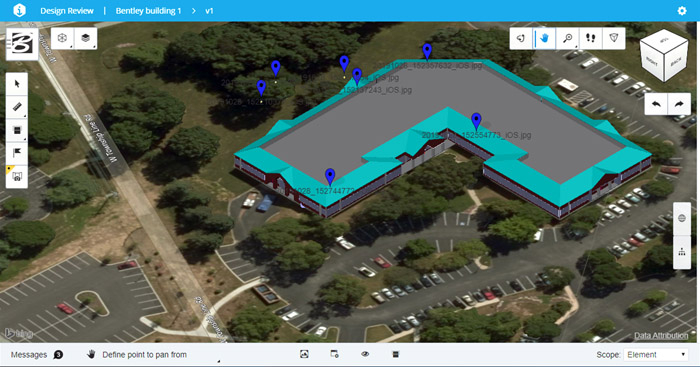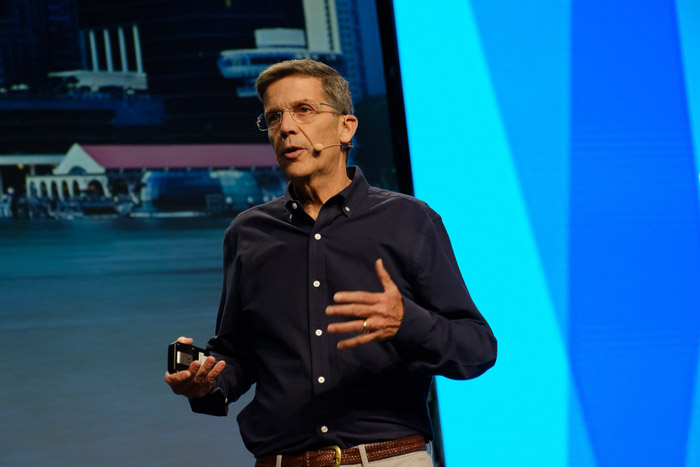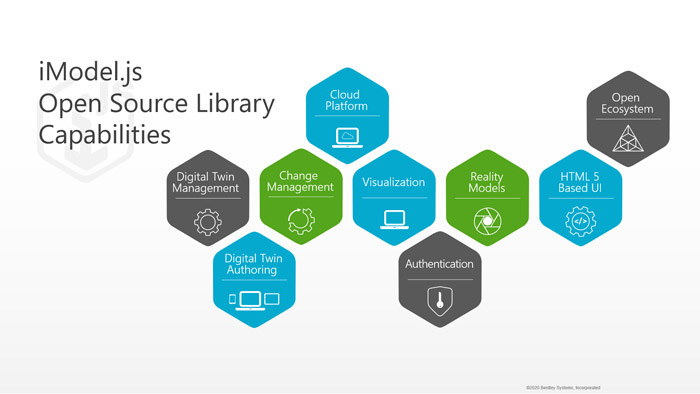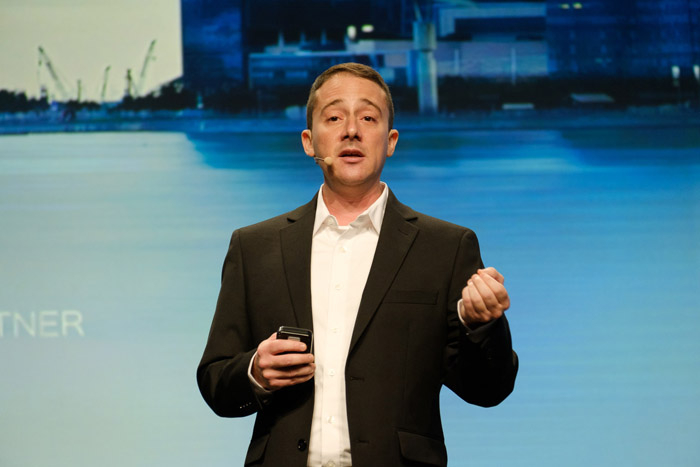There is a huge level of interest in creating digital twins and attaining the “black art” knowledge required to wrangle project data into a single place. Following on from our coverage last year, Martyn Day digs deeper into the subject with Bentley Systems
The concept of creating a digital twin for a project has really captured the imagination of not only designers and constructors, but also owners and operators.
There are many possible use cases and benefits linking the digital realm to reality. But, as always happens in our industry, some software developers jump on the bandwagon, fuelling the hype cycle and generally only succeeding in confusing the market. Too many have used digital twin when what they really mean is the BIM process.
With this in mind, AEC Magazine decided to dig a little deeper into the challenges that the industry faces when creating digital twins and also to explain some of the underlying technologies to deliver beyond the hype. To do this we talked with Keith Bentley, Chief Technology Officer, Bentley Systems and Adam Klatzkin, the company’s vice president of business development – iTwin Services.
Last year at its Year In Infrastructure event in Singapore, Bentley Systems concentrated on explaining its broad digital twin strategy and platform technologies, with firms like Shell and Microsoft providing case studies on their digital twin experiences (read the article here). Bentley Systems has been building its digital twin platform and services quietly over many years, from creating technology as fundamental as an open file format, building connectors and APIs, to offering full delivery services for scanning entire cities and producing accurate, 3D reality models.

Bentley Systems is “all in” on creating, utilising, managing, and distributing digital twins. Keith Bentley described the reality of digital twins as, “The biggest opportunity to improve the overall value contribution of technology to infrastructure since the personal computer. Even with today’s digital twin applications, the opportunities to improve the overall value to the ecosystem are far greater than that of traditional CAD or BIM.”
Digital twins are fundamentally about big data: collecting old, new, live, and future data, geo-referencing it, finding out what has changed, displaying it, and doing something meaningful with it. To be holistic, digital twin technology needs to bridge many boundaries and access data that may be in proprietary formats and within different databases.
Openness
Keith Bentley explained the key precept of the digital twin landscape, “Premise number one of a digital twin is that it’s always going to be a federation of a lot of information sources. Think about IoT [Internet of Things] streams and resource management, asset management. You are not going to buy your digital twin solution from one vendor. There’s no way that one vendor anywhere could take on the mission of supplying all the technology you need for your digital twin.

“When we thought about it, we realised that the way we can be most relevant is by participating in the ecosystem that will be there, making what you consume from Bentley as easily ‘integratable’ as possible into the world of other people’s software and other companies.”
But on the “theory of openness,” everybody in this industry claims to be open. In reality, they talk the talk, but rarely walk the walk. Keith Bentley gave us his definition of openness, “Sure, nobody would ever say, ‘Oh, we’re closed!’ But there are degrees of openness and here (in the context of digital twins), you either mean it or you don’t. My definition is this: a software vendor’s technology is designed and constructed in a manner such that the option to switch vendors is foreclosed or not. And, we say that we’re not designing things, building things, and even selling things that couldn’t be taken and used by another vendor and have customer’s data be stuck.
“It’s true. With the Bentley applications, the Autodesk applications, and all the design applications that exist today, they’re really vendor locked. You’re locked in. And, in the iModel and iModel.js world, we’re endeavouring to make that situation not true. We believe that we can be more relevant if our technology is consumable by people for purposes outside of Bentley’s primary mission,” added Bentley.

iModels
To build a digital twin, data needs to come from multiple sources, in multiple file formats, at different points along the asset’s timeline, from concept to decommissioning. Typically, this data is all over the place and needs to be assembled somewhere. Here, Bentley Systems has created a new version of its iModel collaboration platform to act as an expandable conduit for digital twin data. Called iModel.js, the platform contains capabilities for creating, visualising, querying, mining, synchronising, aligning, and securing digital twin data.
In the building industry, it’s impossible to escape the predominance of Revit. Bentley Systems has created what it calls an iModel Bridge to extract Revit data into iModels. Keith Bentley explained, “We store the primitives as close to their Revit form as we can. If you look at the schema for iModels, you’ll see a lot of commonality with Revit because we know that people are going to want their Revit data to represent what it was when it was in Revit. So, the transformation actually is greater going from DGN into iModels than Revit into iModels.”
In the spirit of openness, Bentley Systems published the source code of iModel.js on GitHub. Anyone, even competitors, can download it, make a copy of it, edit it, or even incorporate it into one of their products. It also means that, fundamentally, the user’s data is never locked in.
Keith Bentley explained, “We fully expect that most people will need features that we won’t have the ability or the capability to create for them. Practically every instance of a digital twin is going to involve a heterogeneous mix of vendors and data sources and use cases. You’re not going to get to all that from Bentley as a bespoke product, like we can in the design world. We think customers will use our libraries to internally create solutions or perhaps developers will make things for sale, and we’ll benefit indirectly. We are okay with that; if there are more iModels in the world, we will have more relevance, more opportunity to sell our iTwin Services, but you don’t have to buy everything from Bentley.”
While iModels are a big part of Bentley Systems’ digital twin world, Keith Bentley was quick to add that, “It’s not true that a digital twin is an iModel, or that an iModel constitutes a digital twin. A digital twin of an infrastructure asset that’s of any magnitude will have a lot of information from many sources. We think that digital twins mean a vast sea of federated data sources, one of which will be an iModel.”
iTwins
Bentley’s iTwin Services builds on top of iModels and are a set of services packaged together to enable the creation of digital twin workflows, such as design review or design insights, as well as workflows that can be developed by third-party organisations. iTwin Services brings all that project data together, especially focusing on Bentley Systems’ expertise in handling and understanding engineering and scanned data.
Underneath iTwin Services, Bentley Systems has a technology called iModelHub, which enables iModels to pull in engineering data from core industry software applications, such as Revit and OpenRoads Designer, wherever it resides. iModelHub acts as a bridge to bring the data into a “normalised data model,” which aggregates CAD, BIM, and GIS data created elsewhere.
As designs inevitably change, are updated, and are modified, they are synchronised via iModelHub. This means that iTwin Services maintains the timeline and sequence of changes to a project, even though the data might be federated across a number of systems.
Keith Bentley explained, “This concept of federating is challenging – combining data sources together to make it appear as a cohesive whole. Engineering data has a lifecycle that follows an approval and review process. Then, the proposed changes become real changes, whereas things like warranty information, inspection records, and resource allocation come and go all the time. So, these assets need to be stored in a different place and have a different way to access it, and therefore will be federated.
“Bentley provides ways that you can form those connections; and in our iModel world, there are ways that you can identify information through links to other databases, mapped back to the source application. Internally, there’s logic in the iModel.js library to know how to visualise it in 3D. Each visualisation always shows some elements from your reality data, your design data, your GIS, and your IoT streams. We just want to make it so that it can all be done as seamlessly as possible.”
Small digital twins
Looking at the many layers of technology and the vast amount of data generated in all phases of design, construction, and operation, the general feeling is that digital twins are expensive to create and really only make sense for large assets, such as process plant and water filtration plants. Adam Klatzkin disagrees,
“Actually, it’s pretty easy to get started at any scale, small or large. We’ve had just as much interest from engineering firms for project digital twins for construction, even without an owner onboard. Many firms are considering how they evolve their businesses into the future and how to offer services to the owners and operators. These firms are starting to become digital integrators.
“So, how do firms change their business model around being relevant for the entire lifecycle of the asset? A lot of them have started exploring digital twin approaches on small projects, or even on small sections of larger projects or larger assets. The commercial model definitely supports small to large assets.”
New build vs. as-built
New-build projects benefit from having all the associated data created digitally and can be made accessible. For pre-existing buildings and assets, digital data might not be so easy to come by. Here, scanning within a survey might well be the starting point of capturing the as-built for a digital twin. Bentley Systems has invested heavily in “reality capture,” the art of either laser scanning or building 3D models from photographs and/or videos.
Klatzkin told us that it was early days, but that Bentley Systems already had users who started flying drones once a month, then weekly, and now daily on projects to use photogrammetry to capture the build phases. They are getting a return on their investment to carry it on.
One transit authority was looking at continuous surveying of a 10-mile stretch of track but at some point, all that data becomes a burden. Bentley Systems is looking at ways to make the capture and storage of this type of data more cost-effective and efficient, as it’s only the changes that need to be identified.

Updates to digital twins
The Bentley Systems vision means that there is a project or design digital twin that is used in the build phase of a building, road, or asset. Then, derived from this, there is a performance digital twin or twins, which could have many uses: to live monitor sensors in a plant, to conduct building analysis, to look at design alternatives for proposed changes, to analyse live data of office uses, and to perform asset management. Given the amount of investment in creating these performance twins, we wondered how these changes to design data drove the updates of the twin models.
“Change propagation of engineering data across multiple digital twins is relatively easy,” explained Klatzkin. “Change is built into iModels and iModelHub from the ground up. So, assuming that those performance digital twins were all the same asset, from the same dataset, then the twin simply subscribes to the change notifications, pulling in those changes. It’s very similar to how branches and forks are managed in source code development.”
Keith Bentley added, “A project digital twin and a performance digital twin will sometimes be different. There will be different aspects modelled in one that aren’t in the other. The essence is the connection through change notification. Once a change is approved and synchronised, you will want to know what the result of those changes was, and then run that through the same mapping process to update the performance iModel. I suspect that a lot of that logic and the ways to synchronise digital twins will be opportunities for third parties to write because there is usually not one type of performance digital twin. They will need applications, platforms, and an ecosystem, and that’s what we’re trying to create with iModel.js.
“If you’re scanning a plant every day, from one day to the next, two data sets may both be large but may also be 92% or 97% the same, or maybe it’s unchanged. Customers need to be able to isolate what is different about the world today versus yesterday. Just having an up-to-date scan isn’t going to be good enough to know what happened. It’s all part of ‘digital twinness’ and also the reason why we say those concepts—being able to track in software and the state of the real world—don’t come into the whole BIM discussion of the last twenty years. Nobody thought about that. It wasn’t considered because it simply wasn’t possible.”
Conclusion
The nature of data in our industry is that it can be as federated as the typical group of 25 or more companies that combine to design and construct assets. The concept of digital twins is about connectedness, and the aim is to bring all this data together, crossing the boundaries of formats, servers, IT silos, politics, and hierarchy. Once wrangled into an open digital twin, it’s possible to gain insights and make more-informed decisions with all the information at your fingertips, and even hook up IoT devices to get real time feedback. This practice applies to all phases: concept, design, construction, operation through to decommissioning.
Bentley Systems’ approach through iModels, iModel.js, iModelHub, and the iTwin Services umbrella focusses on the area it knows best: corralling the engineering data. This tack has led the company to approach openness in a new way, because it can’t provide all the capabilities required and will have to work with a federation of application providers to connect the data to deliver a multitude of client’s needs.
If you enjoyed this article, subscribe to our email newsletter or print / PDF magazine for FREE






